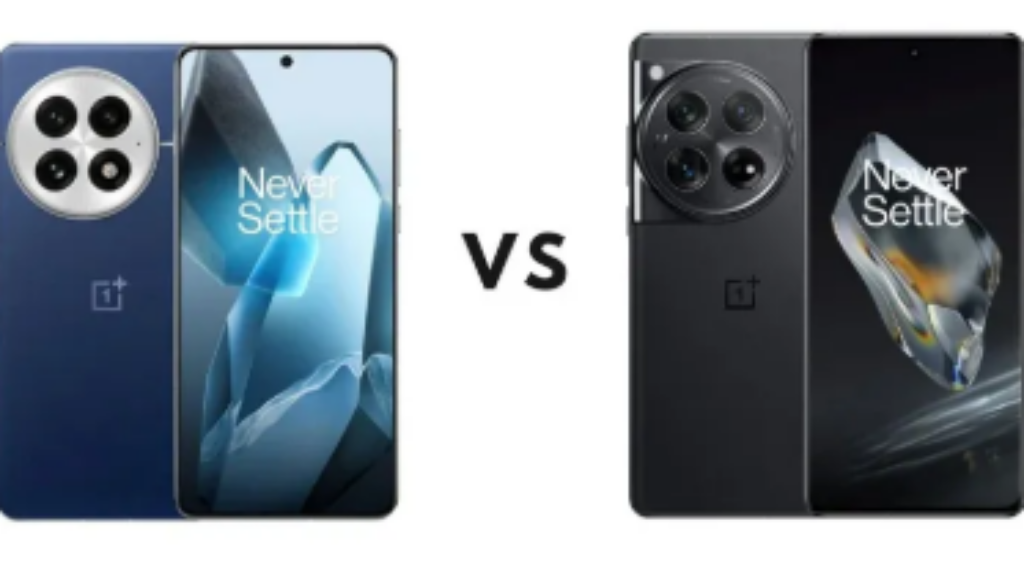With the OnePlus 13, the company appears to have cracked the recipe for creating a superb premium phone, but is it worth upgrading?
OnePlus just announced the OnePlus 13 series globally, including some substantial enhancements and modifications, particularly in the camera and performance departments. Compared to its predecessor, the current OnePlus phone has the Snapdragon 8 Elite, Qualcomm’s fastest processor to date, a new telephoto camera, and a more polished design. While these upgrades may appear enticing on paper, here’s a brief comparison of the OnePlus 12 and OnePlus 13 to help you determine whether the newly released phone is worth the investment.
Design and Display
The OnePlus 13’s design differs somewhat from that of its predecessor, however, the two smartphones may appear identical from the front. However, when you glance at the rear of the phone, they couldn’t be more different.
The black model of the OnePlus 12 had a simulated leather back, but with the OnePlus 13, the company chose a more premium-looking synthetic leather that it claims is more resistant to scratches, stains, and corrosion. While it is too early to determine which one is superior, the OnePlus 13’s imitation leather back is thicker than its predecessor, and as a result, it may last longer if you use the phone for many years.
Another slight but visible difference is that the OnePlus 13’s camera island is no longer attached to the phone’s chassis. The Hasselblad logo appears to have been relocated from the left side of the camera island to the device’s right side. Compared to the OnePlus 12, the OnePlus 13 is also somewhat slimmer, measuring 8.9mm.
One of the most significant changes the OnePlus 13 offers is that it is both IP68 and IP69 certified. Compared to the OnePlus 13, which has IP65 dust and water resistance, this is a huge increase because customers can now dunk their phones in water without worries.
To summarize, IP65 phones are not waterproof and can only withstand low-pressure water jets, whereas IP68 phones may be completely submerged in water. The IP69 certification protects against high-pressure water sprays from any direction.
While the OnePlus 13 retains the same display size as its predecessor, the smartphone manufacturer has chosen a newer LTPO panel and improved the screen protection from Gorilla Glass Victus 2 to Ceramic Guard, which is the same technology used by Apple on the iPhone.
Performance and Software
Another difference between the two devices is performance. While the OnePlus 12 is powered by the Snapdragon Gen 3 processor, the OnePlus 13 uses the far more powerful Snapdragon 8 Elite chipset, which provides up to 25% greater performance while using less power.
OnePlus also appears to have stepped up the game with its newest Android overlay, OxygenOS 15, which is based on Android 15. While OxygenOS 14 is no slouch, the company’s newest skin introduces various new AI functions as well as incredibly smooth animations, making the phone feel faster.
OxygenOS 15 further expands customization choices with new widgets, typefaces, and lock screen themes. OnePlus has launched three new AI-powered picture editing features: AI Unblur, AI Detail Boost, and AI Reflection Eraser. The business also launched a new Notes app that uses generative AI to refine, summarize, and enrich content.
Camera
The OnePlus 12 shoots excellent images for its budget, but the camera was one of the most common complaints among consumers. However, the firm appears to have taken customer input into account with the OnePlus 13.
While the OnePlus 13 appears to feature the same camera sensor as its predecessor, the processing appears to have improved slightly, owing to a mix of software optimization and enhanced ISP on the Snapdragon 8 Elite. OnePlus also increased the ultrawide shooter from 48MP to 50MP with the new phone, however, many may believe that the OnePlus 12’s 64MP periscope telephoto lens with 3x optical zoom is superior to the OnePlus 13’s 50MP periscope telephoto lens with 3x optical zoom.
However, OnePlus claims that despite the lower megapixel camera, the OnePlus 13’s telephoto sensor is better at shooting shots since it features Sony’s latest LYT-600 sensor, which is noted for taking better photos in low light circumstances than the previous sensor.
The OnePlus 12 has a 5,400mAh Li-Po battery, but the newly announced gadget has a larger 6,000mAh Silicon Carbon battery. This should provide longer battery life. The higher battery capacity, along with improved power efficiency, should result in an extra hour or two of use for heavy users.
However, both phones support 100W wired and 50W wireless charging, so the new phone will take slightly longer to completely charge than its predecessor, which isn’t a terrible thing.
Is the new OnePlus 12 or 13 worth upgrading to?
The OnePlus 13 saw considerable improvements in the battery, performance, and camera departments, but the OnePlus 12 remains a strong choice for gamers and multitaskers.
However, if you want to play the latest games while still having a little larger battery and an upgraded telephoto lens, the OnePlus 13 (review) is a good option. However, if you’re happy with the OnePlus 12 (review) and don’t mind not having the new Qualcomm CPU, there’s no incentive to switch to the current model.

